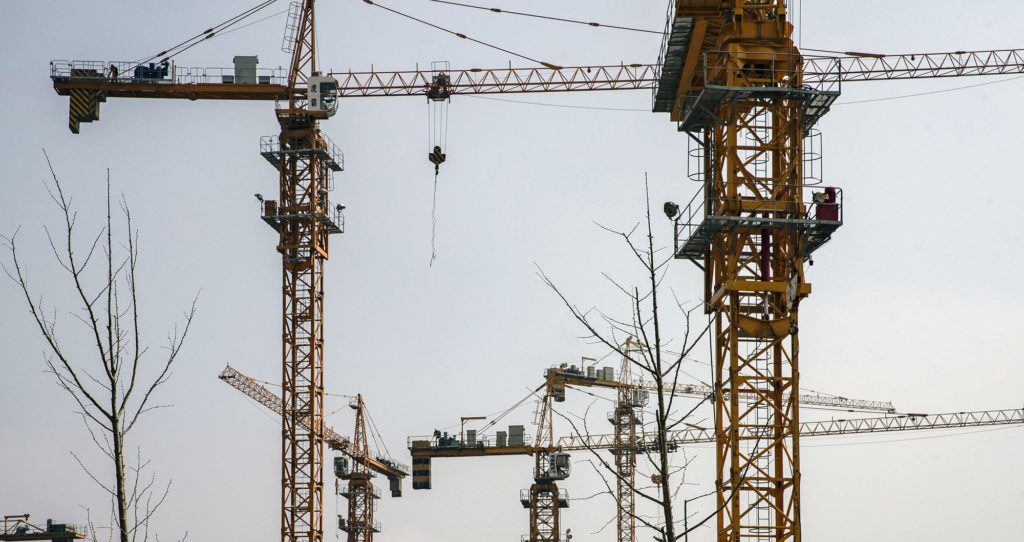(Bloomberg) — Worries about the possible scale of Logan Group Co.’s undisclosed leverage now include talk of a potential debt reorganization as repayment pressure piles up on its $6.8 billion of outstanding bonds.
Considered a higher-quality Chinese developer several months ago, Logan’s credit ratings have been slashed into the equivalent of CCC territory by all three major international assessors, signaling there’s heightened risk that bondholders won’t be made whole. S&P Global Ratings said the builder is likely to restructure its onshore debt given its cash levels and the amounts owed.
Some of Logan’s dollar notes have slumped from near face value in January to just 10 cents on the dollar. Shares have slumped 72% this year despite a record 23% surge Wednesday, part of a rally across Chinese asset classes after Beijing issued a strong promise for policies to boost financial markets and stimulate economic growth.
Throughout 2022 there’s been rising concerns about Logan’s debt, including bond guarantees, helping amplify worries about balance-sheet transparency among Chinese developers. The builder is looking to extend repayment into 2023 on at least two onshore notes and has reportedly yet to repay a loan backing a private bond.
What’s the company?
Founded in 1996, Shenzhen-based Logan focuses on developing residential properties, mainly in the Greater Bay Area comprising Guangdong, Hong Kong and Macau. The company ranked 16th among Chinese builders by contracted sales the first two months of this year, according to estimates from China Real Estate Information Corp.
What’s happening?
Logan’s dollar bonds have had the worst return so far this year among companies in a Bloomberg index of China’s high-yield market at -87%. Its stock is the third-biggest decliner in the Hang Seng Composite Index. Investors have bailed amid concerns over the company’s potential undisclosed debt and ability to meet payment obligations on all its borrowings.
In its latest downgrade of Logan, S&P analysts wrote the company might face debt accelerations, demands which could complicate imminent repayments. Logan’s key domestic unit said in a stock exchange filing last week that its March payment obligations for notes becoming due or puttable and asset-backed securities totaled 5.3 billion yuan ($831 million).
Why does it matter?
Logan’s liquidity troubles are the latest evidence that China’s property crisis is far from limited to a few highly leveraged developers, spilling to the nation’s stronger builders and state-backed players. More than half of Chinese developers’ high-yield offshore notes are trading at less than 50 cents, according to Bloomberg Intelligence.
Debt-transparency concerns hanging over the sector were given a spotlight thanks to Logan, amid a drumbeat of reports that it provided guarantees to loans backing private notes. The company in January denied a story about one such loan before reportedly telling investors it guaranteed no more than $1 billion of private-placement bonds. The state of builders’ debt loads may become clearer in the next several weeks as firms’ 2021 results are due.
What does the company say?
Logan said in a statement to Bloomberg on Tuesday that it won’t “lie flat” regarding debt pressures, noting it’s been making efforts on asset disposals. The builder also pledged to treat fairly and communicate actively with domestic and overseas financial institutions.
Before the loan-guarantee denial, Logan had also said in January it didn’t have any privately placed debt. Key unit Shenzhen Logan Holdings Co. said the same about itself in last week’s Shenzhen Stock Exchange filing, adding it also hasn’t sold wealth-management products to professional investors or done external commercial paper financing.
Consistent with language in recent filings by peers, Shenzhen Logan also said its cash flow has been pressured by a combination of factors including slumping home sales, heightened near-term debt maturities and an inability to sell new bonds to investors. But the company is “determined and confident to address short-term liquidity problems.” Logan Group’s combined January-February contracted sales fell 53% from a year earlier, according to Hong Kong filings.
What do the ratings firms say?
Logan was hit by five downgrades last week from the three major international credit assessors — twice each by S&P and Fitch Ratings and once by Moody’s Investors Service. Nonpayment of private-placement notes “is rapidly rising” and “the situation appears to have worsened drastically in a short time,” said S&P.
The builder has “low margin of safety in its liquidity and increasing refinancing risks,” Fitch analysts wrote in their latest ratings cut. “Negative news flow has continued to affect market confidence in the company, and we believe it is reliant on alternative funding sources such as asset disposals for debt repayment.”
Moody’s had the highest rating among the three before Tuesday’s three-notch cut to Caa2. Analyst Cedric Lai cited “heightened refinancing and default risks” and said Logan “will still face a liquidity gap” despite planned asset sales.
What are traders watching for next?
As Logan attempts to deal with debt due this month, onshore traders are closely watching if offshore bond payments will take priority over local ones. That could help color the outcome of extension talks on a 1.83 billion yuan note due March 22.
Also, Logan’s 2021 annual report due by month’s end should provide more detail on the firm’s debt picture. By S&P’s count, the developer has 15.3 billion yuan of bonds and syndicated loans coming due this year, excluding private-placement notes.
(Updates stock data in the third paragraph and market data in the sixth paragraph.)
More stories like this are available on bloomberg.com
©2022 Bloomberg L.P.











